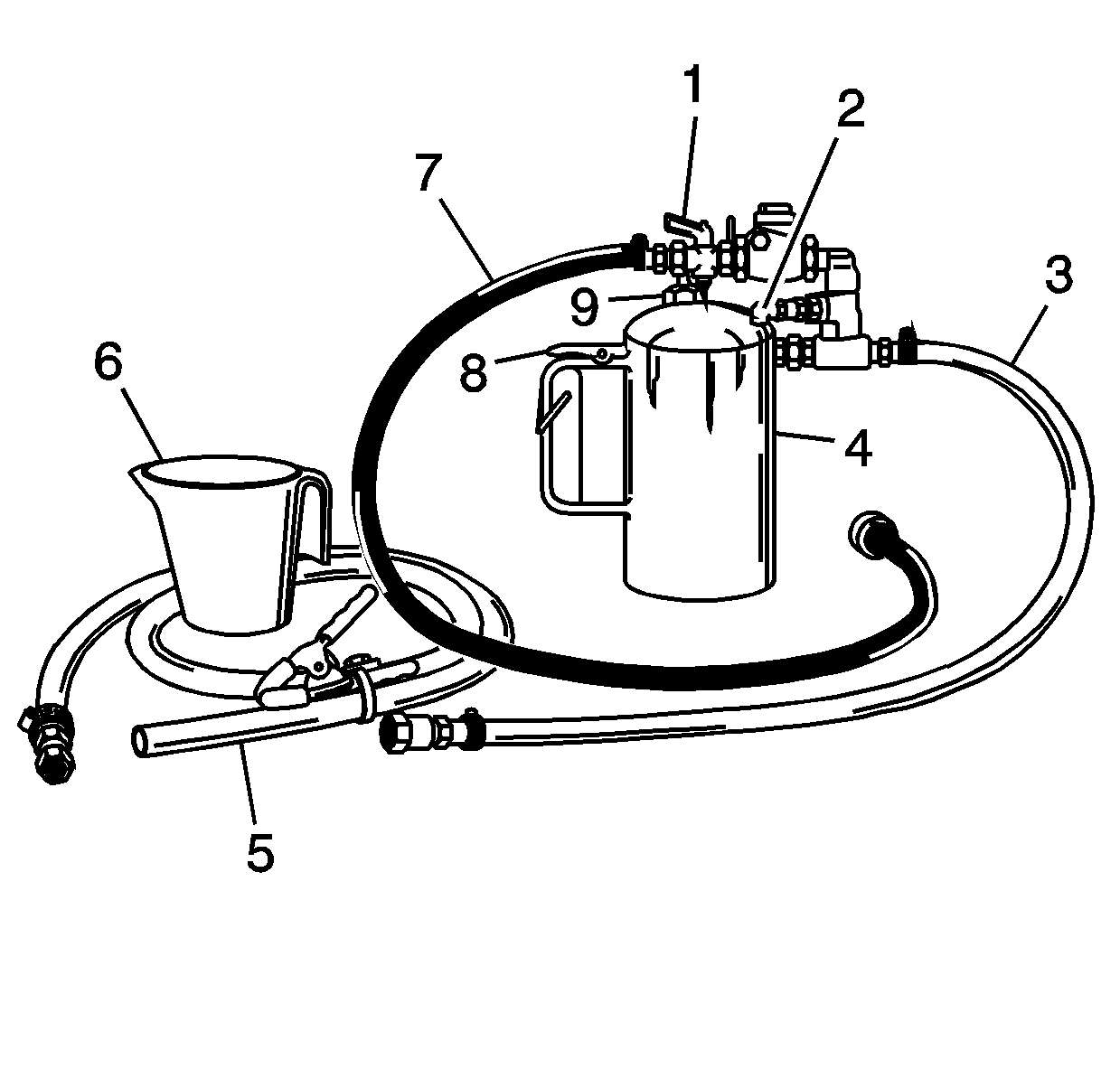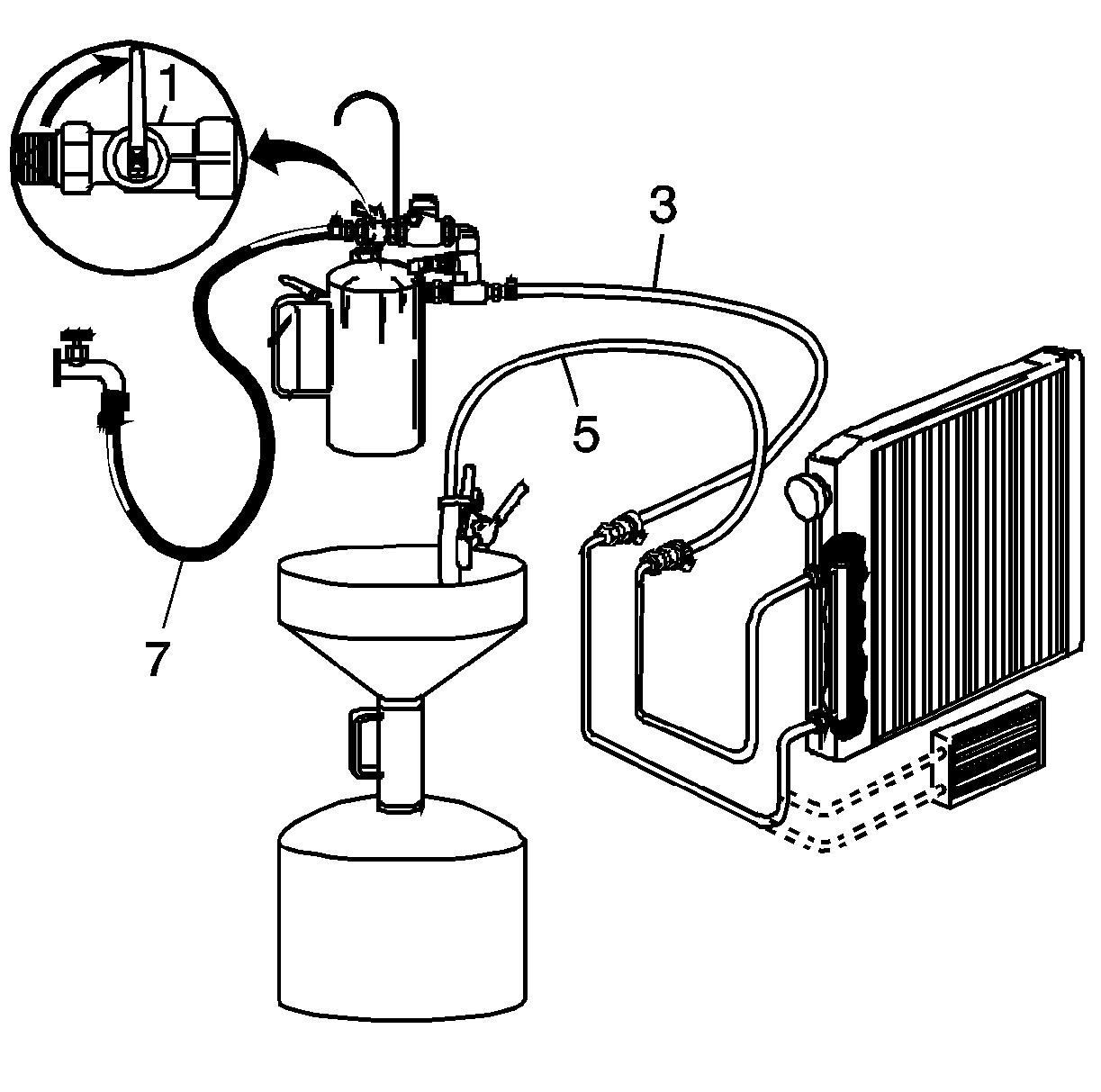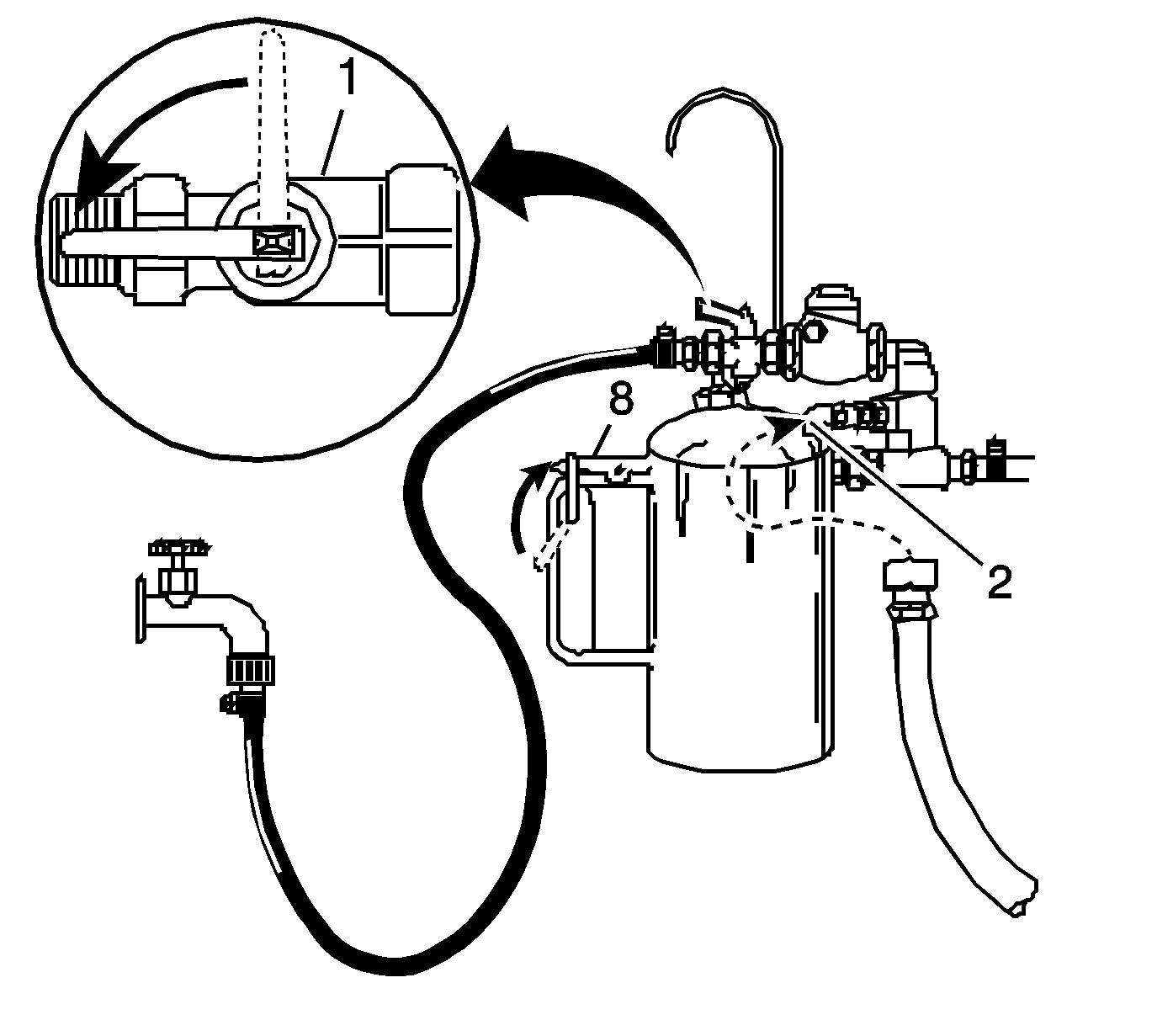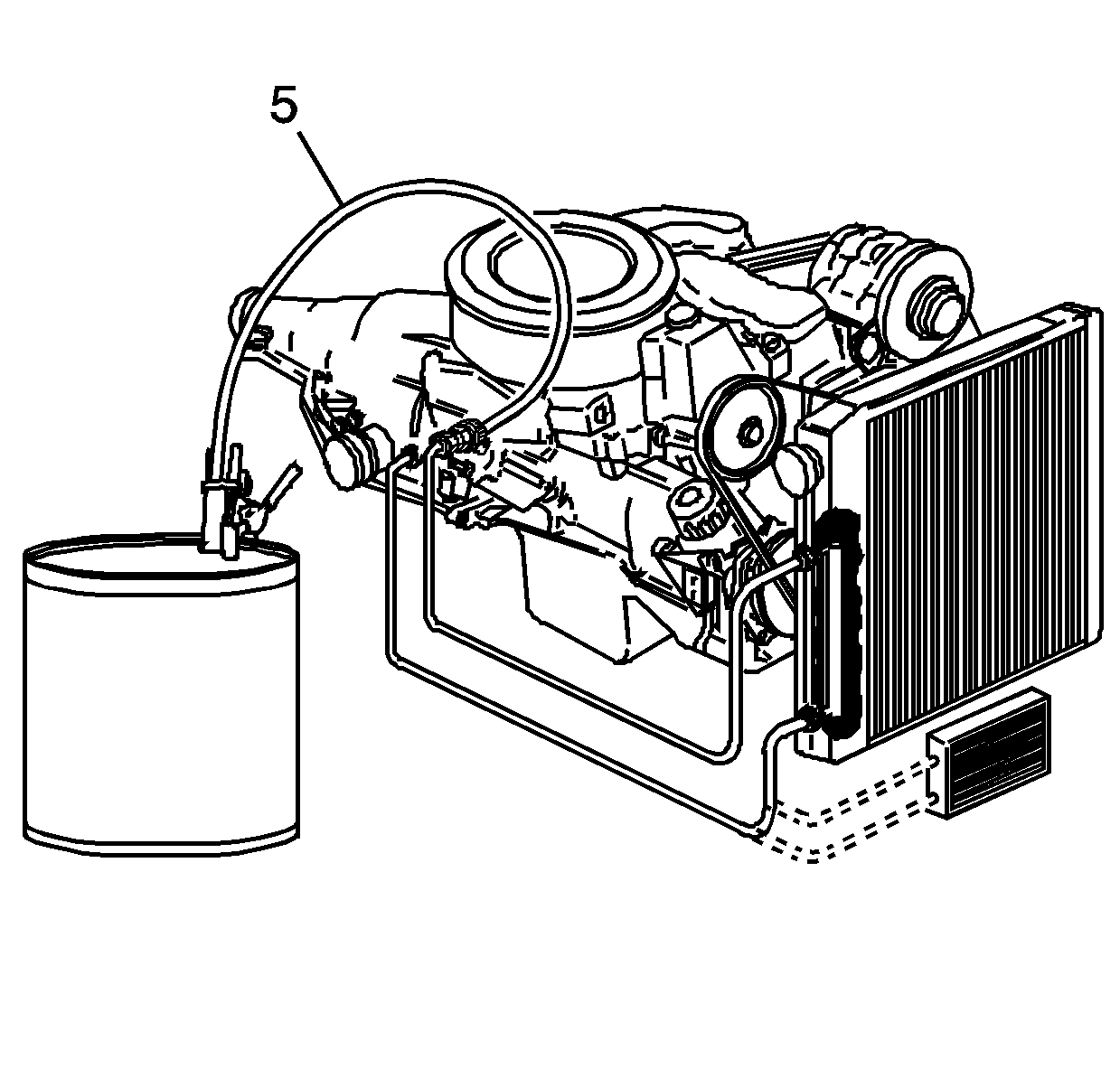Important: The
J 45096
- Automatic Transmission Oil Cooler Flush and Flow Test Tool can be used to flush the transmission oil cooler system on an Allison equipped vehicle, but the flow
meter should not be utilized.
GM studies indicate that plugged or restricted transmission oil coolers and pipes cause insufficient transmission lubrication and elevated operating temperatures which can lead to premature transmission wear-out. Many cases could have been prevented
by following published procedures for transmission oil cooler flushing and flow checking. This procedure includes flushing and flow checking the auxiliary transmission oil cooler, if equipped. GM requires that transmission oil cooler flushing and flow
checking be performed whenever a transmission is removed from the vehicle for service within warranty, including:
| • | Torque converter replacement |
Only GM Goodwrench DEXRON® III automatic transmission fluid should be used when doing warranty repair on GM transmissions.
Tools Required
| • | J 35944-A
Transmission Oil Cooler and Line Flusher |
| • | J 35944-22
Transmission Oil Cooler Flushing Fluid |
| • | J-44835-1
Transmission Oil Cooler Flusher Adapters |
| • | Water supply (hot water recommended) |
| • | Water hose at least 16 mm (5/8 in) ID |
| • | Shop air supply (with water/oil filters, regulator and pressure gauge) |
| • | Air chuck (with clip if available) |
| • | Minimum 19 L (5 gallon) pail or similar container with lid |
Preparation
- After the repair or replacement transmission is installed in the vehicle, do not reconnect the oil cooler pipes.

Important:
| • | Do not substitute with solutions that contain alcohol or glycol. Use of solutions that contain alcohol or glycol may damage
J 35944-A
, oil cooler components or transmission components. |
| • | The flushing fluid (
J 35944-22
) is environmentally safe, yet powerful enough to cut through transmission fluid to dislodge any contaminants from the cooler. The safety precautions on the label
regarding potential skin and eye irritations associated with prolonged exposure, are typical precautions that apply to many similar cleaning solutions. It should be noted that according to GM, use of other non-approved fluids for cooler flushing can have
an adverse reaction to the seals inside the transmission. |
- Remove the fill cap (9) on the
J 35944-A
and fill the flusher tank (4) with 0.6 L (20-21 oz) of
J 35944-22
flushing solution using
the measuring cup (6). Do not overfill.
- Install the fill cap (9) on the
J 35944-A
and pressurize the flusher tank (4) to 550-700 kPa (80-100 psi), using the shop air supply at the tank air valve (9).

- Connect the
J-44835-1
Adapters to the transmission oil cooler lines.
- Connect the
J 35944-A
discharge hose (5) to the oil cooler return pipe (top connector).
- Clip the discharge hose (5) onto the oil drain container.
- Attach the
J 35944-A
to the undercarriage of the vehicle with the hook provided and connect the flushing system feed supply hose (3) from the
J 35944-A
to the oil cooler feed pipe (bottom connector).
- With the water supply valve (1) on the
J 35944-A
in the OFF position, connect the water supply hose from the
J 35944-A
to the water supply at the
faucet.
- Turn ON the water supply at the faucet.
Initial Flush
- Turn the
J 35944-A
water supply valve (1) to the ON position and allow water to flow through the oil cooler and pipes for 10 seconds to remove any remaining transmission fluid. If water
does not flow through the oil cooler and pipes, the cause of the blockage must be diagnosed and the plugged component must be repaired or replaced. Continue with the cooler flushing and flow check procedure once the blockage is corrected.
- Turn the
J 35944-A
water supply valve (1) to the OFF position and clip the discharge hose (5) onto a suitable container, preferably with a lid, to avoid splashback.

- Turn the
J 35944-A
water supply valve (1) to the ON position
and depress the trigger (8) to mix cooler flushing solution into the water flow. Use the clip provided on the handle to hold the trigger (8) down. The discharge will foam vigorously when the solution is introduced into the water stream.
Important: Flushing for approximately 2 minutes in each cooler line direction will result in a total of about 31 to 38 L (8 to 10 gallons) of waste fluid. This mixture of water and flushing fluid is to be captured
in a suitable container, preferably with a lid.
- Flush the oil cooler and pipes with water and solution for two minutes. During this flush, attach the shop air supply 825 kPa (120 psi) to the flushing system feed air valve (2) located on the
J 35944-A
for 3 to 5 seconds at the end of every 15-20 second interval to create a surging action.
- Release the trigger (8) and turn the
J 35944-A
water supply valve (1) to the OFF position.
Back Flush
- Disconnect both hoses from the oil cooler pipes and then connect them to the opposite oil cooler pipe. This will allow the oil cooler and pipes to be back flushed.
- Repeat steps 3 and 4 of the INITIAL FLUSH procedure.
- Release the trigger (8) of the
J 35944-A
and allow water only to rinse the oil cooler and pipes for one minute.
- Turn the
J 35944-A
water supply valve (1) to the OFF position and turn OFF the water supply at the faucet.
- Attach the shop air supply to the flushing system feed air valve (2) on the
J 35944-A
and blow out the water from the oil cooler and pipes. Continue until no water comes out of the discharge hose
(5).
Flow Check

- Disconnect both hoses from the oil cooler pipes. Connect the oil cooler feed pipe
(bottom connector) to the transmission. Connect the return pipe (top connector) to the discharge hose (5). (This will require the use of
J-44835-1
) Clip the discharge hose (5) onto an empty oil drain container.
- Confirm the transmission is filled with automatic transmission fluid.
- Start the engine with the transmission in PARK range and run for 5 seconds at 2400 RPM. A minimum of 2.2 L (2.3 quarts) must be discharged during this 5 second run time.
| • | If fluid flow is greater than 2.2 L (2.3 quarts) in 5 seconds at 2400 RPM, go to step 4. |
| • | If fluid flow is less than 2.2 L (2.3 quarts) in 5 seconds at 2400 RPM, perform the following diagnosis: |
| • | Disconnect the oil cooler feed line at the radiator. Connect the discharge hose (5) to the cooler feed
line. Clip the discharge hose (5) to the empty oil drain container. Start the engine with the transmission in PARK range and run for 5 seconds at 2400 RPM. A minimum of 2.2 L (2.3 quarts) must be discharged during this 5 second
run time at 2400 RPM. Do the following according to the flow rate: |
| - | Insufficient feed flow: inspect the transmission |
| - | Sufficient feed flow: inspect the oil cooler return pipe, the oil cooler located in the radiator, and the auxiliary oil cooler. |
- Remove the discharge hose (5), reconnect the cooler feed and return pipes to the transmission and refill the unit to the proper fluid level. Inspect the transmission oil cooler pipe connections at the radiator, the auxiliary cooler and the transmission
for leaks.
Clean-up
- Disconnect the water supply hose (7) from the
J 35944-A
and bleed any remaining air pressure from the flusher tank (4).
- Remove the fill cap (9) from the
J 35944-A
and return any unused flushing solution to its container. Rinse the
J 35944-A
with water. Do not store
the
J 35944-A
with flushing solution in it.
- After every third use, clean the
J 35944-A
as described in the instructions included with the tool.
- Dispose of any waste water/solution and transmission fluid in accordance with local regulations.




